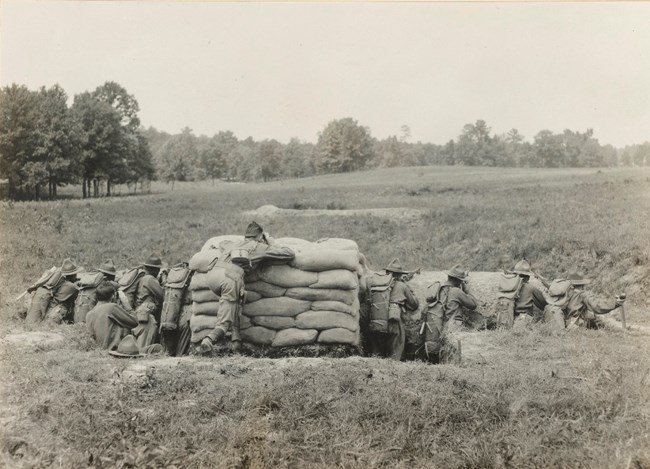Last updated: April 11, 2019
Article
Preparing For the Great War at Chickamauga Battlefield

National Archives Image ID 31476971
In September 1863, thousands of Union and Confederate soldiers from across the nation fought and died at Chickamauga Battlefield. A little over 50 years later, their grandchildren returned as soldiers to Chickamauga. This time, they did not meet as foes, but as countrymen united in a cause to win the Great War. Throughout the spring of 1917, tensions between the United States and Germany escalated to the breaking point. In January, Americans learned that Germany had attempted to persuade Mexico to join the Great War, and offered to return much the American southwest to Mexico. Then, in February, Germany announced that was it resuming unrestricted submarine warfare, a move that reignited a national debate about America’s declared neutrality. Finally, in April, the United States declared war on Germany. A new generation of Americans was about to march off to war.
In 1917, Chickamauga and Chattanooga National Military Park was still under the management of the War Department. The Army, just as they had done during the Spanish American War, utilized the national military parks as training depots for thousands of soldiers preparing to fight in the trenches of Western Europe. At Chickamauga Battlefield, the War Department established three camps – Camp Warden McLean, Camp Greenleaf, and Camp Forrest. Camp Forrest was the smallest of the three, and served primarily as a training hub for engineers. Camp Warden McLean was a Reserve Officer Training Center, and its barracks were located in the field that today is home to the Chickamauga Battlefield Visitor Center. Camp Greenleaf was by far the largest of the World War I encampments at Chickamauga. Located in a sprawling complex throughout both north and south Dyer Fields, Camp Greenleaf was home to the army’s medical training operations. Doctors, medics, nurses, ambulance teams, and even entire field hospital staffs trained among the monuments at Chickamauga. Just north of the park, in Fort Oglethorpe, were hundreds more buildings, including a prisoner of war camp for captured Germans and American civilian internees suspected of disloyalty under the Espionage Act of 1917. All total, more than 1,500 buildings along with six miles of trenches and rifle pits dotted the landscape in and around the park. 60,000 American servicemen passed through Chickamauga Battlefield on their way to Europe – approximately the same size as the U.S. Army that fought at Chickamauga in 1863.
After the war ended, the army took down most of the buildings on the battlefield and began to fill in the trenches that crisscrossed the fields around Horseshoe Ridge and Snodgrass Hill. In the early 1930s, President Franklin Roosevelt transferred Chickamauga and Chattanooga National Military Park from the War Department to the National Park Service – an agency committed to preserving the landscape to commemorate the wars of our past as opposed to preparing for the wars of the present. Today, little remains of the World War I camps on Chickamauga Battlefield. Some of the park’s hiking trails follow the routes of old Army roads, and an observant visitor might occasionally see traces of building foundations poking up through the grass.
The US Army at Chickamauga in 1863 may have helped ensure that “government of the people, by the people, for people shall not perish from the earth.” But the soldiers at Chickamauga in 1917 and 1918 continued “the great task remaining before us” and helped to “ensure that the world must be made safe for democracy.”

National Archives Photo/NARA ID Number 26422309
